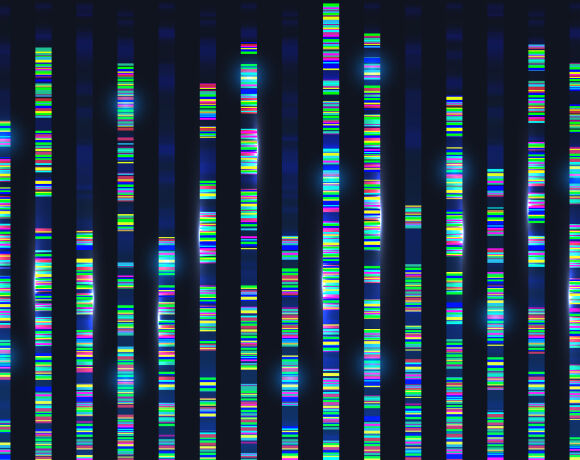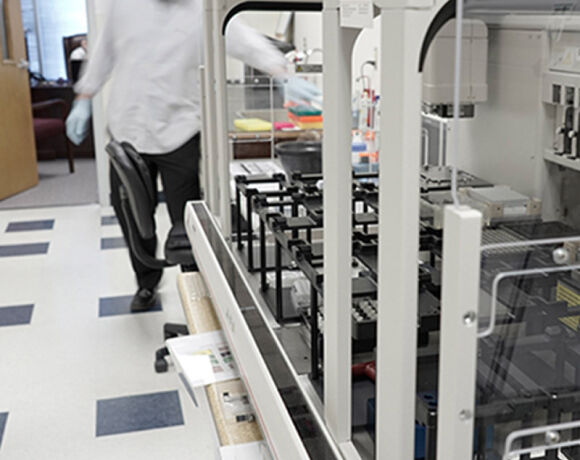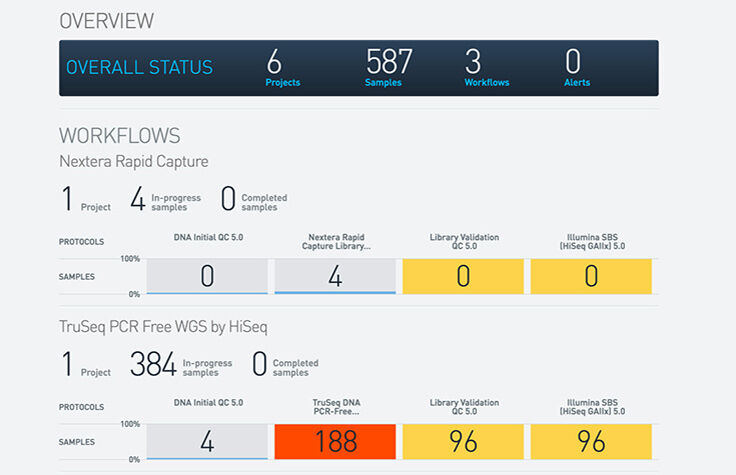Informatics Infrastructure and Pipeline Setup
Discovery is possible when the right infrastructure is in place
Streamline your bioinformatics and data analysis pipeline so you can concentrate on the things that matter
Bioinformatics Infrastructure and Pipeline Considerations
What if the next big breakthrough has nothing to do with genomics but everything to do with the underlying bioinformatics pipeline you use to understand genomic data? At Illumina, we believe that the bioinformatics infrastructure you have set up—from the sequencer to the analysis tools you use—plays a critical role in your success.
The interdisciplinary nature of bioinformatics and genomics data analysis calls for a bioinformatics pipeline that promotes collaboration and reflects the way you can most efficiently and reliably process and analyze genomic data – now and into the future. Setting up a new next-generation sequencing (NGS) pipeline or simply adding components to an existing pipeline requires careful thought and planning.

Build or Buy Informatics Tools?
Labs often weigh considerations for purchasing bioinformatics tools from a reputable vendor against the advantages of in-house customization. The cost of developing do-it-yourself tools often exceeds the cost of purchasing tools, and commercial software developed with the user in mind tends to be easier for staff to use.
Many labs agree that if you can find a tool that meets most of your needs, has flexibility for customization, and is well supported, purchasing is a better use of resources.
Learn more about the experiences of several labs who recently decided to purchase a LIMS.
Read Article
Benefits of Lab Automation
Introducing automation addresses several common challenges facing high-throughput genomic labs, such as ensuring consistency and reproducibility. A LIMS provides:
- Sample tracking and standardized reporting
- Automated library prep
- Integration of instruments and liquid-handling robots into workflows
- End-to-end management of samples, tests, and results
Automated Library Preparation Solutions
We partner with leading automation vendors to automate our library prep kits on a range of liquid handlers. These methods eliminate the time and effort required for you to develop your own automation scripts.
Learn More About Library Prep AutomationAutomating Routine Lab Procedures
LIMS users highlight how lab automation software helped optimize cumbersome workflows and scale up throughput.
Read ArticleSequencing Lab Automation
Explore solutions designed to meet the needs of large-scale genomic analysis labs, from production-scale sequencers to high-volume multiomics data analysis and management, multiplexing, and more. Hear from scientists who have set up high-capacity sequencing labs and automated workflows.
Learn More About High-Throughput SequencingMicroarray Lab Automation
We offer liquid-handling robots, array loaders, and other automation packages for labs conducting microarray-based genotyping and methylation studies. These packages help streamline the assay workflow and integrate sample preparation and array scanning.
Learn More About High-Throughput GenotypingExplore Array Automation Packages

A LIMS Tailored for Genomics Labs
BaseSpace Clarity LIMS is our laboratory information management system. Designed specifically for genomics labs and optimized for NGS, BaseSpace Clarity LIMS integrates with instruments, helps labs track and manage samples, and streamlines the overall operations in a lab. In contrast to complicated homegrown systems, BaseSpace Clarity LIMS is designed with the end user in mind, encouraging wider adoption by lab staff.
View ProductData Sharing and Collaboration

Prepare your data for publication
Sequencing data has been traditionally difficult for non-bioinformatics experts to understand. Illumina solutions offer intuitive report formats that are tailored to biologists and are available in publication-ready formats.
Researchers can launch workflows with a click of a button and output user-friendly reports that can be easily shared with collaborators or public databases.

Collaborate
Sharing large sets of data can present obstacles involving arcane FTP protocols, hard drive limits, and incompatible device interfaces.
Illumina Connected Analytics and BaseSpace Sequence Hub make sharing data with trusted collaborators as simple as ever. With a click of a button, users can share individual sequencing runs or entire projects. Sharing is instantaneous and accessible everywhere.
Sharing Solutions
Illumina Connected Analytics
A modular, secure data platform for scalable multiomics data management, analysis, and exploration. Generate insights with speed through shared datasets.
Learn MoreBaseSpace Sequence Hub
The Illumina cloud-based genomics computing environment for NGS data management and analysis. It fosters collaboration and innovation with simplified data sharing.
Learn MoreBaseSpace Clarity LIMS
A LIMS that helps laboratories track samples and optimize workflows. Lab managers can access real-time data from mobile devices to update stakeholders or collaborators.
Learn MoreSample Management
Easily Manage Samples and Set Up Experiments
High-throughput genomics labs face the difficulty of managing/tracking samples and designing custom assays. We offer user-friendly tools to help start and manage your sequencing or microarray project.
Our informatics tools help you import biological sample information, design and pool libraries, prepare sequencing runs, create custom targeted sequencing panels, and generate sample sheets.
Sample Management for High-Throughput Labs
Modern genomics research generates an unprecedented amount of data. Faced with increasing data volumes and sample throughput, labs seeking to streamline lab operations and cut costs must modernize their approach.
A laboratory information management system (LIMS) is software that allows you to effectively manage samples and associated data. With this system, your lab can automate workflows and integrate with instruments to improve lab efficiency.
Learn More About LIMSSimple Sequencing Experiment Setup
Setting up and running sequencing experiments is easy with software designed for Illumina sequencing systems. The specific software tool to use depends on which Illumina sequencer is utilized.

Importance of Standards and QC
With rapidly advancing NGS technology, it’s critical to have quality control (QC) checks for the large volumes of data being generated. Illumina provides guidelines for using controls and standards in sequencing experiments, enabling researchers to maintain confidence in the quality of their data and experiment results.
- See what high-quality sequencing data should look like. View data examples
- Learn more about sequencing quality scores. Understand the numbers
- Learn more about PhiX, the standard control DNA used for Illumina sequencing experiments. View products
Learn More
Sequence File Formats
From FASTQ and BCL file formats to raw sequence file conversion, our tools provide the formats you need for successful secondary or tertiary analysis of NGS data.
Sequencing Data Analysis
User-friendly tools smooth the process of analyzing sequencing data, so you can spend more time doing research and less time configuring workflows.
Lab Information Management Systems
Understand what a LIMS is and how it can help genomics labs with sample tracking, workflow automation, and downstream data analysis.